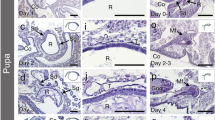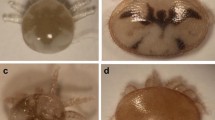Abstract
Reduction of reproductive organs in workers is one of the most important traits for caste specialization in social insects. In this study, we investigated the morphology of the sperm storage organ, the spermatheca, in workers of the honeybees Apis cerana and Apis mellifera from Japan. All examined workers of the two species retain a small spermatheca. Ultrastructural observations indicate that the spermatheca of honeybee workers consists of conspicuous muscular layers which correspond with the sperm pump and that the epithelium surrounded by these muscular layers represents the spermatheca duct. As this epithelium shows intact cellular morphology, we conclude that the spermatheca duct and the sperm pump do not degenerate, whereas the spermatheca reservoir has completely degenerated. All workers of A. cerana and most workers of A. mellifera lack the spermatheca gland completely. A few workers of A. mellifera possess the opening of the spermatheca gland, but its structure seems to be degenerated. The spermathecal width including the muscular layers showed a weak, but significant positive correlation with ovariole numbers in A. cerana, but not in A. mellifera. The degree of spermatheca gland degeneration seems to be unrelated to ovariole number. The morphological features of degeneration in honeybee workers are different from those of the vestigial spermatheca in ant workers, indicating that morphological worker virginity has evolved in a different way.





Similar content being viewed by others
References
Adam, A. (1912) Bau und Mechanismus des Receptaculum seminis bei den Bienen, Wespen und Ameisen. Zool. Jahrb. 35, 1–74
Alexander, B.A. (1991) Phylogenetic analysis of the genus Apis (Hymenoptera: Apidae). Ann. Entomol. Soc. Am. 84, 137–149
Allsopp, M.H., Calis, J.N.M., Boot, W.J. (2003) Differential feeding of worker larvae affects caste characters in the Cape honeybee, Apis mellifera capensis. Behav. Ecol. Sociobiol. 54, 555–561
Beekman, M., Calis, J.N.M., Boot, W.J. (2000) Parasitic honeybees get royal treatment. Nature 404, 723
Billen, J.P.J. (1982) The Dufour gland closing apparatus in Formica sanguinea Latreille (Hymenoptera, Formicidae). Zoomorphology 99, 235–244
Billen, J. (2006) Morphology and ultrastructure of the Dufour gland in workers of social wasps (Hymenoptera, Vespidae). Arthropod. Struct. Dev. 35, 77–84
Calis, J.N.M., Boot, W.J., Allsopp, M.H., Beekman, M. (2002) Getting more than a fair share: nutrition of worker larvae related to social parasitism in the Cape honey bee Apis mellifera capensis. Apidologie 33, 193–202
Caveney, S. (1969) Muscle attachment related to cuticle architecture in Apterygota. J. Cell Sci. 4, 541–559
Dallai, R. (1975) Fine structure of the spermatheca of Apis mellifera. J. Insect Physiol. 21, 89–109
Gobin, B., Ito, F., Peeters, C., Billen, J. (2006) Queen–worker differences in spermatheca reservoir of phylogenetically basal ants. Cell Tissue Res. 326, 169–178
Gobin, B., Ito, F., Billen, J., Peeters, C. (2008) Degeneration of sperm reservoir and the loss of mating ability in worker ants. Naturwissenschaften 95, 1041–1048
Gotoh, A., Billen, J., Hashim, R., Ito, F. (2008) Comparison of spermatheca morphology between reproductive and non-reproductive females in social wasps. Arthropod Struct. Dev. 37, 199–209
Hambleton, E.J. (1928) The anatomy and histology of the reproductive organs of the worker bee (Apis mellifera). Unpublished thesis, Cornell University.
Hepburn, R., Radloff, S.E. (2002) Apis mellifera capensis: an essay on the subspecific classification of honeybees. Apidologie 33, 105–127
Hölldobler, B., Wilson, E.O. (1990) The ants. Harvard University Press, Cambridge
Honeybee Genome Sequencing Consortium (2006) Insights into social insects from the genome of the honeybee Apis mellifera. Nature 443, 931–949
Ito, F. (2010) Notes on the biology of the Oriental amblyoponine ant Myopopone castanea: queen–worker dimorphism, worker polymorphism and larval hemolymph feeding by workers (Hymenoptera: Formicidae). Entomol. Sci. 13, 199–204
Ito, F., Ohkawara, K. (1994) Spermatheca size differentiation between queens and workers in primitive ants: relationship with reproductive structure of colonies. Naturwissenschaften 81, 138–140
Ito, F., Sugiura, N., Higashi, S. (1994) Worker polymorphism in the red-head bulldog ant (Hymenoptera: Formicidae), with description of nest structure and colony composition. Ann. Entomol. Soc. Am. 87, 337–341
Jordan, L.A., Allsopp, M.H., Beekman, M., Wossler, T.C., Oldroyd, B.P. (2008) Inheritance of traits associated with reproductive potential in Apis mellifera capensis and Apis mellifera scutellata workers. J. Hered. 99, 376–381
Kapil, R.P. (1962) Anatomy and histology of the female reproductive system of Apis indica F. (Hymenoptera, Apidae). Insectes Soc 9, 145–163
Khila, A., Abouheif, E. (2008) Reproductive constraint is a developmental mechanism that maintains social harmony in advanced ant societies. Proc. Natl. Acad. Sci. USA 105, 17884–17889
Khila, A., Abouheif, E. (2010) Evaluating the role of reproductive constraints in ant social evolution. Philos. Trans. R. Soc. Lond. B Biol. Sci. 365, 617–630
Kugler, J., Orion, T., Ishay, J. (1976) The number of ovarioles in the Vespinae. Insectes Soc. 23, 525–533
Lai-Fook, J. (1967) The structure of developing muscle insertions in insects. J. Morphol. 123, 503–528
Martins, G.F., Serrão, J.E. (2002) A comparative study of the spermatheca in bees (Hymenoptera; Apoidae). Sociobiology 40, 711–720
Martins, G.F., Serrão, J.E., Furieri, K.S. (2005) Notes of the spermatheca of Vespidae and Sphecidae (Hymenoptera). Sociobiology 45, 119–127
Matsuura, M. (1995) Social wasps of Japan in color. Hokkaido University Press, Sapporo
Pabalan, N., Davey, K.G., Packer, L. (1996) Comparative morphology of spermathecae in solitary and primitively eusocial bees (Hymenoptera; Apoidea). Can. J. Zool. 74, 802–808
Phiancharoen, M., Pirk, C.W.W., Radloff, S.E., Hepburn, R. (2010) Clinal nature of the frequencies of ovarioles and spermathecae in Cape worker honeybees, Apis mellifera capensis. Apidologie 41, 129–134
Poole, H.K. (1970) The wall structure of the honey bees spermatheca with comments about its function. Ann. Entomol. Soc. Am. 63, 1625–1628
Schoeters, E., Billen, J. (2000) The importance of the spermathecal duct in bumblebees. J. Insect Physiol. 46, 1303–1312
Snodgrass, R.F. (1956) The anatomy of honey bee. Comstock Publishing Associates, Cornell University Press, Ithaca
Spradbery, J.P. (1973) Wasps: an account of the biology and natural history of solitary and social wasps. Washington University Press, Seattle
Tanaka, E.D., Hartfelder, K. (2004) The initial stages of oogenesis and their relation to differential fertility in the honey bee (Apis mellifera) castes. Arthropod Struct. Dev. 33, 431–442
Wheeler, D.E., Krutzsch, P.H. (1994) Ultrastructure of the spermatheca and its associated gland in the ant Crematogaster opuntiae (Hymenoptera, Formicidae). Zoomorphology 114, 203–212
Winston, M.L. (1987) The biology of the honey bee. Harvard University Press, Cambridge
Acknowledgments
We thank S. Yano, T. Kurahashi, and K. Sato for their assistance with the sample collection. Thanks are also due to A. Vandoren for the section preparation. This work is supported by a JSPS Research Fellowships for Young Scientists.
Author information
Authors and Affiliations
Corresponding author
Additional information
Manuscript editor: Klaus Hartfelder
Morphologie de la spermathèque atrophiée chez les ouvrières des abeilles, Apis cerana et A. mellifera au Japon.
Morphologie / spermathèque / ouvrière / dimorphisme de caste / contrainte reproductive / degré de dégénération
Morphologie der rudimentären Spermatheka bei Arbeiterinnen der Honigbienen Apis cerana and A. mellifera aus Japan
Spermathekamorphologie / Honigbienenarbeiterin / Kastendimorphismus / limitierender Faktor der Reproduktion / Grad der Gewebedegeneration
Rights and permissions
About this article
Cite this article
Gotoh, A., Ito, F. & Billen, J. Vestigial spermatheca morphology in honeybee workers, Apis cerana and Apis mellifera, from Japan. Apidologie 44, 133–143 (2013). https://doi.org/10.1007/s13592-012-0165-6
Received:
Revised:
Accepted:
Published:
Issue Date:
DOI: https://doi.org/10.1007/s13592-012-0165-6




